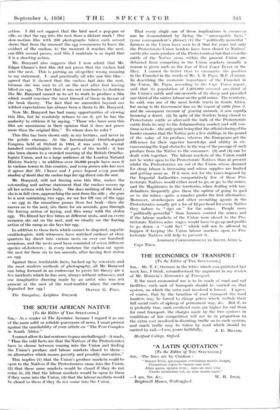[To the Editor of THE SPECTATOR.] SIR,—Very few of your
readers will be deceived by Mr. Bunyard's futile efforts to twist my statements in his endeavour to prove the strange theories which no one but himself believes.
In statirig that I now admit that cuckoos do not lay their eggs direct into the nest, he is deliberately misconstruing my writings and beliefs. I have most emphatically stated that, in my opinion, cuekoos always lay their eggs into the nests of the fo-sterers, and never deposit the'egg with the beak. What I -did state in thy article in Country Life, to which Mr. Bunyard refers, is that the method of laying is a shooting
action. I did not suggest that the bird used a pop-gun or rifle, or shot the egg into the nest from a distant mark ! Our slow-motion film with 200 photographs taken each second shows that from the moment the egg commences to leave the oviduet of the cuckoo, to the moment it reaches the nest, one-fifth second passes, and this I maintain is so rapid that it is a shooting action.
Mr. Bunyard also suggests that I now admit that Mr. Edgar Chance's first film did not prove that the cuckoo laid into the nest. This is putting an altogether wrong meaning to my statement. I—and practically all who saw this film— agreed that it showed that the cuckoo _laid into the nest, because she was seen to sit on the nest after first having lifted an egg. The fact that it was not conclusive to doubters like Mr. Bunyard caused us to set to work to produce a film which would convince the most biassed of those in favour of the beak theory. The fact that we succeeded beyond our wildest expectations has always been a thorn to Mr. Bunyard.
Now Mr. Bunyard has had many opportunities of viewing this film, but he resolutely refuses to see it, yet he has the audacity to criticise it by saying, Those who have seen this film are unanimous in their opinion that it does not prove more than the original film." To whom does he refer ?
This film has been shown only in my lectures, and never in the public cinemas. At the International Ornithological Congress held at Oxford in 1934, it was seen by several hundred ornithologists from all parts of the world ; it has also been shown to a crowded meeting of the British Ornitho- logists Union, and to a large audience at the London Natural History Society ; in addition over 50,000 people have seen it in various towns in this country, and every person who has seen it agrees that Mr. Chance and I prove beyond every possible shadow of doubt that the cuckoo lays her egg direct into the nest.
Mr. Bunyard, still not having seen this film, makes the astounding and untrue statement that the cuckoo covers up all her actions with her body. She does nothing of the kind ; she is in full view, approaching the nest from the side ; she goes to a nest containing two eggs, we see her lift one of the eggs —no egg in the meantime passes from her beak—then she moves on to the nest, sits there for six seconds, goes through the forcing action of laying, and flies away with the stolen egg. We filmed her five times at different nests, and on every occasion she sat on the nest, and we clearly see the forcing action of the rump as she lays her egg.
In addition to these facts which cannot be disputed, capable ornithologists, with witnesses, have watched cuckoos at close quarters lay direct into various nests on over one hundred occasions, and the nests used have consisted of seven different species of.fosterers ; in every instance the cuckoo sat upon the nest for from six to ten seconds, after having first stolen an egg.
Against these irrefutable facts, backed up by scientists and the most modern methods of photography, all Mr. Bunyard can 'bring forward in an endeavour to prove his theory are a few incidents which he has seen, always without witnesses, and one imaginative drawing made by an artist who was not present at the nest of the reed-warbler when the cuckoo
deposited her egg ! OLIVER G. PIKE.
The Bungalow, Leighton Buzzard.







































 Previous page
Previous page